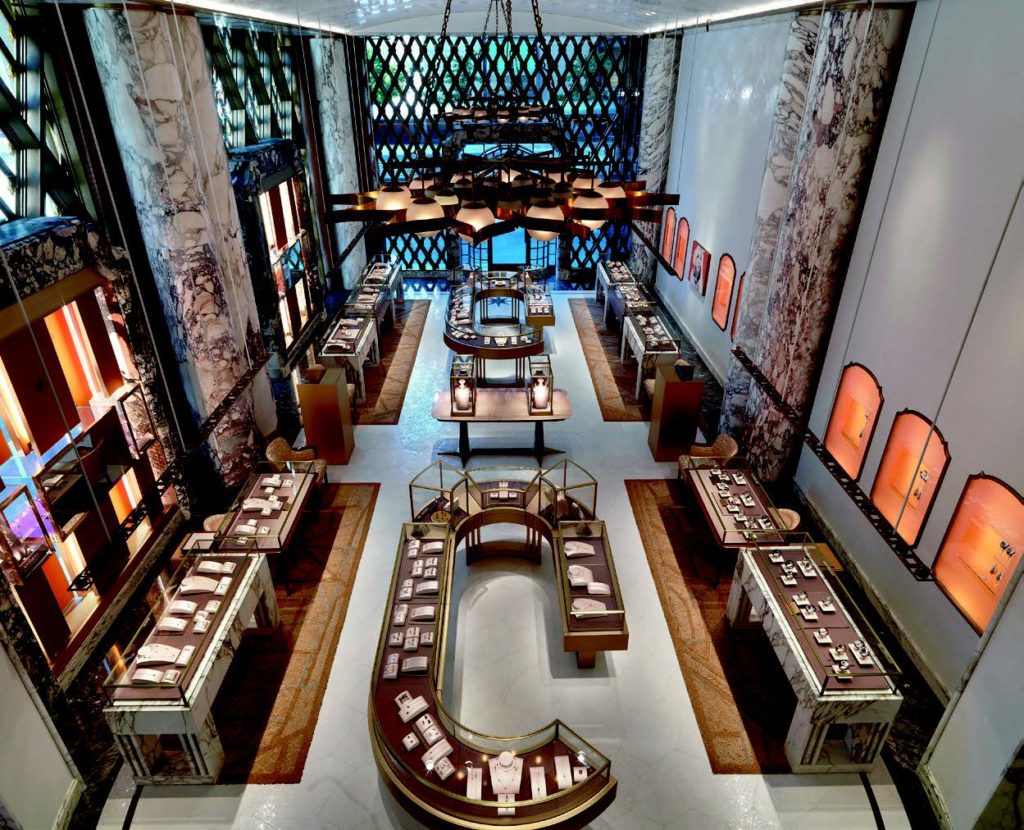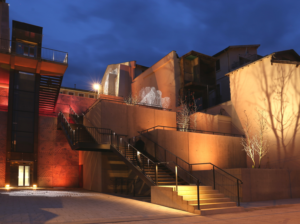NICOLAS MARTIN (LVMH LIGHTING)
Les 16 et 17 mai 2018, à Paris, lors de l’événement interne « LIFE in Stores » organisé par LVMH1, Nicolas Martin, Lighting Manager du Groupe, y a réuni ses fournisseurs partenaires en termes d’innovation, de services et de fiabilité. À cette occasion, il les a conviés à adhérer officiellement à l’« Eco Lighting Label Lighting For Good », véritable think tank portant sur l’éco-conception des produits LED. Du 22 au 24 octobre prochains, Nicolas Martin présentera, à New York, cette initiative sous le nom de « Lighting for Good ».
Sera alors présenté le label « Eco-Design », conçu en collaboration avec la conceptrice lumière Tiphaine Treins2, et avec l’expertise du laboratoire québécois CIRAIG qui, depuis 2001, fait référence au niveau de l’analyse du cycle de vie des produits, des procédés et des services.
Lancé au sein du groupe LVMH dès 2012, le programme « LIFE » (comprenez LVMH Initiatives For the Environnement) a, tout d’abord, été intégré dans le plan stratégique de chacune des 75 Maisons que compte le Groupe, « les clients étant de plus en plus sensibles au fait que les produits qu’ils utilisent respectent mieux l’environnement ». Ensuite, en 2016, dans le cadre de « LIFE 2020 », quatre autres objectifs ont été ajoutés, dont l’un porte sur les sites devant être respectueux de l’environnement. À savoir : améliorer d’au moins 10 % l’efficacité environnementale, notamment des 4 590 boutiques3 du Groupe. « Au même titre que celle de nos produits, la conception de nos magasins intègre les valeurs de créativité, d’innovation et d’excellence chères au groupe LVMH. Cela passe, bien sûr, par le fait de garantir la performance environnementale de tous les magasins de nos Maisons. C’est un vecteur de progrès considérable dans la poursuite de nos objectifs », considère Toni Belloni, DG délégué du Groupe. Si, dans les boutiques, la climatisation et l’éclairage se partagent équitablement la consommation électrique, la rénovation des installations de climatisation s’avère financièrement lourde et techniquement complexe, tandis que « celle des installations d’éclairage permet d’améliorer rapidement les performances énergétiques des espaces de vente », expliquait Nicolas Martin dans l’édition de LUX 297. « La généralisation de la technologie LED contribue à cette performance », ajoutait-il en rappelant que les commerces restent des espaces de séduction dans lesquels les visiteurs doivent ressentir une impression de bien-être et d’accueil. La lumière y contribue pleinement pour « encore mieux s’exprimer et donner à vivre aux clients ». Ainsi, en 2013, est lancé le programme « LVMH Lighting ». Son objectif ? Accompagner les architectes des Maisons dans l’installation d’éclairages LED pour une mise en valeur optimale des espaces de ventes et des produits.

EXPÉRIENCE À VIVRE
À New York, du 22 au 24 octobre prochains, l’événement organisé par Nicolas Martin sera basé sur le même principe que celui de Paris : trois espaces dans la Tour LVMH4, sur la 57e avenue, construite, en 1999, par l’architecte français Christian de Portzamparc. En premier lieu, le Lighting Café où, dans un cadre convivial, interviendront des concepteurs lumière, Nicolas Martin s’attachant à faire apprécier les lighting designers par les architectes et aménageurs œuvrant pour les Maisons, afin de les inciter à renouveler leur éclairage en faisant appel aux meilleurs spécialistes. Avec une vingtaine de « Shadow Designers », définition préférée par le lighting manager à celle de concepteur lumière, la collaboration s’établit à trois niveaux :
LA LUMIÈRE AU CŒUR DE L’EXPÉRIENCE CLIENT
Nicolas Martin en a la conviction : « l’éclairage participe de l’expérience et de l’émerveillement des clients en magasin ». Solution sûre, verte, durable et économique, la technologie LED permet également aux architectes de faire preuve d’une sophistication inégalée en matière de design lumineux, de sublimer les produits de manière subtile tout en offrant un confort visuel optimal.
Cette solution se traduit, notamment, par des sources lumineuses cachées permettant au regard de se concentrer sur le produit présent par un travail minutieux pour éviter les éblouissements et les transitions abruptes entre des ambiances lumineuses trop contrastées.
Boutique Bulgari, New York, 5e Avenue. Architecture par Peter Marino. Lighting par METIS, fourni par LUCE5.
- tout d’abord, « l’ombre et la lumière » modélisant le sujet pour qu’il se détache ;
- ensuite, « l’environnement » représentant le fond entre 3 et 5 fois moins éclairé ;
- enfin, le « glittering » caractérisé par des éclats de lumière projetés sur les matériaux brillants.
Leur objectif ? Offrir une expérience à vivre faite de découverte et de mystère. « En quelque sorte, il s’agit d’exprimer l’art de la suggestion par la lumière », précise Nicolas Martin en opposant « l’orgie lumineuse », observée en grande distribution, « qui rejette l’ombre ». Pour lui, « la lumière du luxe n’est pas celle des hyper ou supermarchés qui montre tout, tout de suite, dans un esprit d’efficacité et de simplicité ». À l’inverse, « nous œuvrons pour favoriser la balade parmi les différents espaces de vente ». Par ailleurs, le Lighting Manager est favorable aux solutions de lumière dynamique, respectueuse du cycle circadien. « La lumière du jour changeant à chaque seconde, pourquoi l’éclairage n’évolue-t-il pas dans ce sens?»
DEUX PRIORITÉS : EXCELLENCE ET INNOVATION
D’autant plus que la technologie LED, associée au déploiement du numérique, le permet aujourd’hui. En témoigne le développement de « la boîte à outils lumière » constitué en partenariat avec une vingtaine de fournisseurs qui présenteront leurs dernières réalisations (souvent des prototypes) dans un deuxième espace, créé au cœur de l’exposition new yorkaise, un troisième étant quant à lui dédié à l’initiative « Lighting For Good ».
1 Voir LUX 297, mai-juin 2018, p. 36-37.
2 Voir encadré « Shadow Designers » p. 34.
3 Le programme « LIFE 2020 » a déjà généré 20 % d’amélioration énergétique : 10 % via l’électricité verte ; 10 % via l’éclairage LED et la climatisation.
4 Cette tour de 100 mètres de hauteur, comptant 23 étages, abrite le siège du groupe LVMH aux États-Unis.
| NICOLAS MARTIN (LVMH LIGHTING) From “LIFE in Stores” in Paris, to “Lighting for Good” in New York On May 16-17, 2018, in Paris, at the in-house “LIFE in Stores” event organized by LVMH1, Nicolas Martin, Group Lighting Manager, brought together its suppliers to talk about innovation, services, and reliability. On that occasion, he asked them to sign up to the “Eco Lighting Label”, a think tank for the eco-design of LED products. At an upcoming event in New York on October 22-24, Nicolas Martin will be presenting this initiative under the name “Lighting for Good”. This event will see the unveiling of the “Eco-Design” label, designed in conjunction with the lighting designer Tiphaine Treins2, and with the expertise of the Quebec research organization CIRAIG which, since 2001, has been the standard setter in analyzing product lifecycle, procedures and services. n 2012, LVMH Group launched the “LIFE” (LVMH Initiatives For the Environment) program, which is incorporated in the strategic plan of each of the 75 Houses that comprise the Group, “as customers are increasingly sensitive to whether the products they use are environmentally friendly.” Then, in 2016, as part of “LIFE 2020”, four more goals were added, one of which related to respect for the environment. Specifically: improve the environmental efficiency of 4,590 stores by at least 10%3. “The design of our products, just like the design of our stores, incorporates the values of creativity, innovation and excellence that are fundamental to LVMH Group. Of course, this means guaranteeing the environmental performance of all of our Houses’ stores. This is a challenging milestone when pursuing our goals,” says Group Managing Director Toni Belloni. Although air-con and lighting in stores each use the same amount of electricity, upgrading air-con is expensive and technically complex, while “upgrading lighting is a quick way of making retail areas more energy efficient,” says Nicolas Martin in issue 297 of LUX. “Extending the use of LED technology contributes to this performance,” he says, emphasizing that stores have to be inviting spaces where shoppers have to feel good and welcomed. Lighting contributes to this in a big way, “providing even more atmosphere and further enhancing the customer experience.” So the “LVMH Lighting” program was launched in 2013. Why? To help House architects develop LED lighting decisions to showcase retail spaces in the best possible way. CUSTOMER EXPERIENCE In New York, on October 22-24, the underlying principle of the event organized by Nicolas Martin will be the same as for Paris. It will feature three areas in the LVMH Tower4 on 57th Avenue, built in 1999 by the French architect, Christian de Portzamparc. First of all, the Lighting Café, where lighting designers will engage in a convivial atmosphere, with Nicolas Martin encouraging architects and developers working for the House to appreciate the contributions of the lighting designers, to encourage them to upgrade their lighting, calling on the best possible specialists. With some 20 “Shadow designers” – a term that the lighting manager prefers to “lighting designers” – the collaboration takes place at three levels: – first, “light and shadow”, modeling the subject so that it stands out; – then, “the environment”, representing the background with between 3 and 5 times less illumination; – lastly, “glittering”, characterized by shards of light projected on to bright objects. Their purpose? To offer a vibrant experience born of discovery and mystery. “In a way, it’s about expressing the art of suggestion through light,” says Nicolas Martin, in contrast to the “orgy of light” that pervades big retail stores “that reject shadow.” For him, “luxurious illumination is not the lighting of hypermarkets and supermarkets, which shows everything immediately and aims for efficiency efficacy and simplicity.” In contrast, “we encourage strolling, wandering, through the various areas of our sales floor.” The Lighting Manager also favors dynamic lighting, which follows circadian rhythms. “Daylight changes by the minute, so why not have our lighting do the same?” TWO PRIORITIES: EXCELLENCE AND INNOVATION Especially since LED technology, which is an outcome of the digital revolution, now enables this. As witnessed by the development of the “lighting tool box”, built in partnership with some 20 suppliers who will showcase their latest products (often prototypes) in a second area, created in the middle of the New York exhibition, with a third space dedicated to the “Lighting for Good” initiative. 1. See LUX 297, May-June 2018, pp. 36 and 37. 2. See “Shadow Designers” p. 34. 3. The “LIFE 2020” program has already generated a 20% improvement in energy use: 10% via green electricity; and 10% via LED lighting and air-conditioning. 4. This 23-story, 100m-tall tower houses LVMH’s headquarters in the United States. LIGHTING IS CENTRAL TO THE CUSTOMER EXPERIENCE Nicolas Martin strongly believes: “lighting plays a part in the customer’s experience and enchantment in store.” A safe, green, long-lasting and economic solution, LED technology also allows architects to demonstrate unparalleled sophistication in lighting design, to subtly enhance products while offering optimal visual comfort. This solution involves using carefully arranged hidden light sources to focus the customer’s gaze on the product without experiencing glare and without abrupt transitions between contrasting lighting ambiences. |
